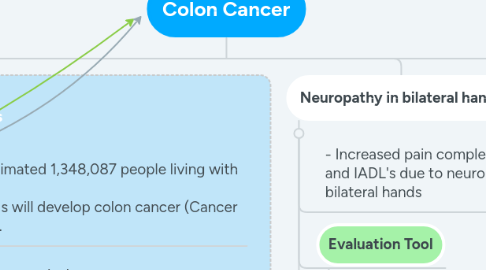
1. Prevalence/ Incidence/ Prognosis
1.1. PREVALENCE: In 2017, an estimated 1,348,087 people living with colon cancer in U.S. INCIDENCE: 1 in 20 individuals will develop colon cancer (Cancer of the rectum and colon, n.d.).
1.2. PROGNOSIS: The overall 5-year survival rate for people of all ages is 63%
1.2.1. (Colorectal cancer: statistics, 2020).
2. Neuropathy in bilateral hands
2.1. - Increased pain completing ADL and IADL's due to neuropathy in bilateral hands
2.2. Evaluation Tool
2.2.1. McGill Pain Scale
2.2.1.1. (Gewandter, Chaudari, Ibegbu, Kitt, Serventi, Burke, Culakova, Kolb, Sluka, Tejani, & Mohile, 2019)
2.3. Intervention
2.3.1. Approach: Prevent, Establish, Restore
2.3.2. Transcutaneous Electrical Nerve Stimulation
2.3.2.1. (Gewandter et al., 2019)
2.3.3. Type: Preparatory method
3. Generalized weakness
3.1. - Unable to work as senior warehouse manager due to decreased strength and endurance
3.2. Evaluation Tool
3.2.1. MMT
3.2.1.1. (Baschung, de Brui, Sterkele, Maurer, de Bie, & Knols, 2018).
3.2.2. Grip Dynamometer
3.2.3. (Baschung, de Brui, Sterkele, Maurer, de Bie, & Knols, 2018).
3.3. Intervention
3.3.1. Approach: Prevent, Resotre, Maintain
3.3.2. Strengthening through functional activities, ROM exercises to prevent contractures
3.3.2.1. (Ko, Ha & Kang, 2017)
3.3.3. Type: Therapeutic Exercise, preperatory method
4. Possible cognitive dysfunction
4.1. - Difficulty concentrating for small periods of time due to cognitive decline
4.2. - Unable to fulfill responsibilities at work due to impaired cognitive abilities
4.3. Evaluation Tool
4.3.1. Mini- mental test, EFPT
4.4. Intervention
4.4.1. Approach: Modify, maintain, restore
4.4.2. Environmental modifications to the work place to decrease the cognitive demand
4.4.2.1. (Tang-Wai, Knopman, Geda, Edland, Smith, Ivnik, Tangalos, Boeve, Petersen, 2003)
4.4.2.2. Type: Preparatory method: AT and Environmental modifications
4.4.3. Paper and pencil or computer based programs to improve attention
4.4.3.1. Type: Preparatory Task
4.4.4. (Giles, Radomski, Wolf, Champagne, Corcoran, Kuhaneck, Morrison, Nadeau, Obermeyer, & Toglia, 2019)
5. Excessive fatigue
5.1. - Unable to fulfill role as father and husband due to excessive fatigue
5.2. Evaluation Tool
5.2.1. Modified Fatigue Impact Scale
5.2.1.1. (Garner, Kumari, Lanyon, Doherty & Zhang, 2015)
5.3. Intervention
5.3.1. Approach: Modify, Prevent
5.3.1.1. Energy conservation techniques
5.3.1.1.1. Type: Education & Training
6. Raynauds Syndrome
6.1. - Numbness and tingling occurring in his hands - Cold fingers or toes - Color changes in skin due to cold or stress (Raynaud's disease, 2017).
6.2. PROGNOSIS: It is rarely dangerous and is typically a lifelong condition that does not get worse There are many treatments that can help manage the disease (Raynaud's phenomenon, 2018).
6.3. PREVALENCE: As of 2015, 4.85% of the general population INCIDENCE: 0.25% (Garner, Kumari, Lanyon, Doherty, & Zhang, 2015).
6.4. - Unable to regulate body temperature in bilateral hands due to Raynaud's syndrome
6.5. - Client may experience finger ulcers due to Raynaud's syndrome, impacting ability to manipulate objects/ items
6.6. Evaluation Tool
6.6.1. Skin integrity
6.6.1.1. (Hughes and Herrick, 2017)
6.6.2. Raynauds Condition Score
6.6.2.1. Khanna, Maranian, Gregory, & Khanna, 2010)
6.7. Intervention
6.7.1. Approach: Education
6.7.2. Educate client to keep hands warm with gloves, blankets, or pockets. Apply lotion regularly to keep hands from drying out
6.7.2.1. (Raynaud's phenomenon management and treatment, n.d.)
7. Model: MOHO
7.1. MOHO values motivation as a key factor that affects performance in daily occupations (Cole & Tufano, 2008). Using MOHO we would want to learn about the client's interests and values and use this to develop an appropriate treatment plan.
7.2. Frame of Reference: Biomechanical and Rehabilitative
7.3. The biomechanical FOR is appropriate for the client because he has decreased ROM, strength and endurance. The rehabilitative approach focuses on making the client as independent as possible (Cole & Tufano, 2008). The client was a senior warehouse manager and requires physical abilities. Incorporating biomechanical and rehabilitative techniques will help the client build strength to return to his job.
8. Outcomes
8.1. Participation
8.1.1. Within 4 weeks, Client will independently participate in at least 5 social activities with family a week.
8.2. Prevention
8.2.1. In 4 weeks, Client will independently demonstrate energy conservation techniques while working
8.3. Role Competence
8.3.1. Within 4 weeks, Client will independently lift 9/10 10 lb packages for work.
8.3.2. Within 4 weeks, client will independently utilize three environmental modifications to improve competence in work.
8.4. Quality of life
8.4.1. Within 4 weeks, Client independently perform dressing tasks with pain of 2/10 or less.

